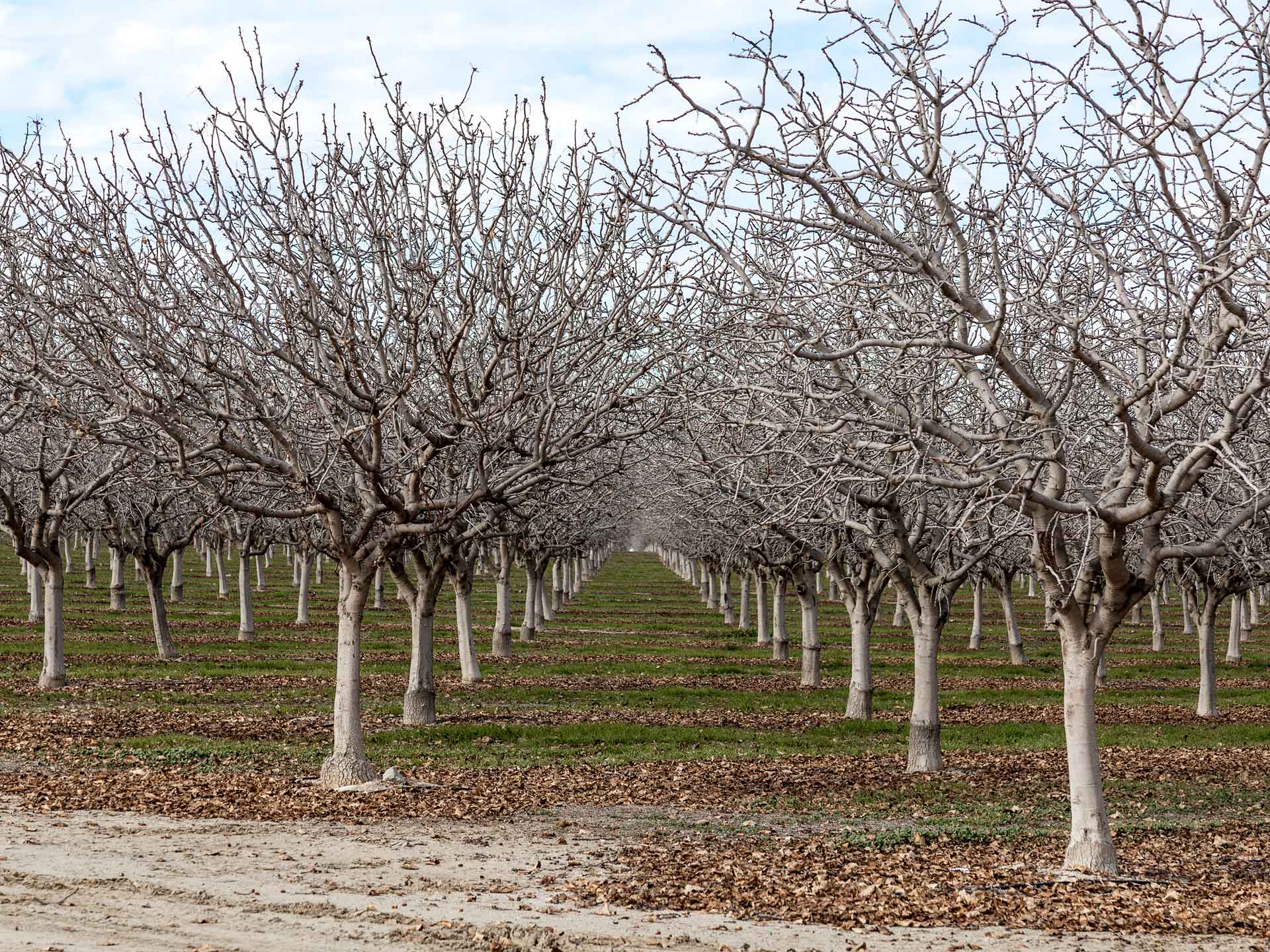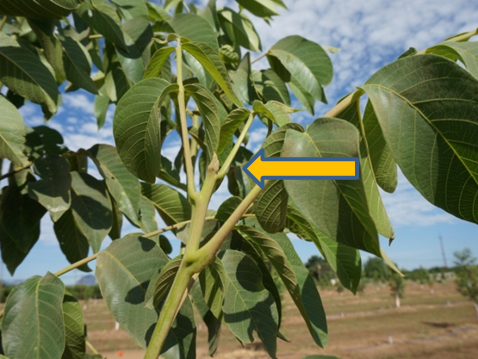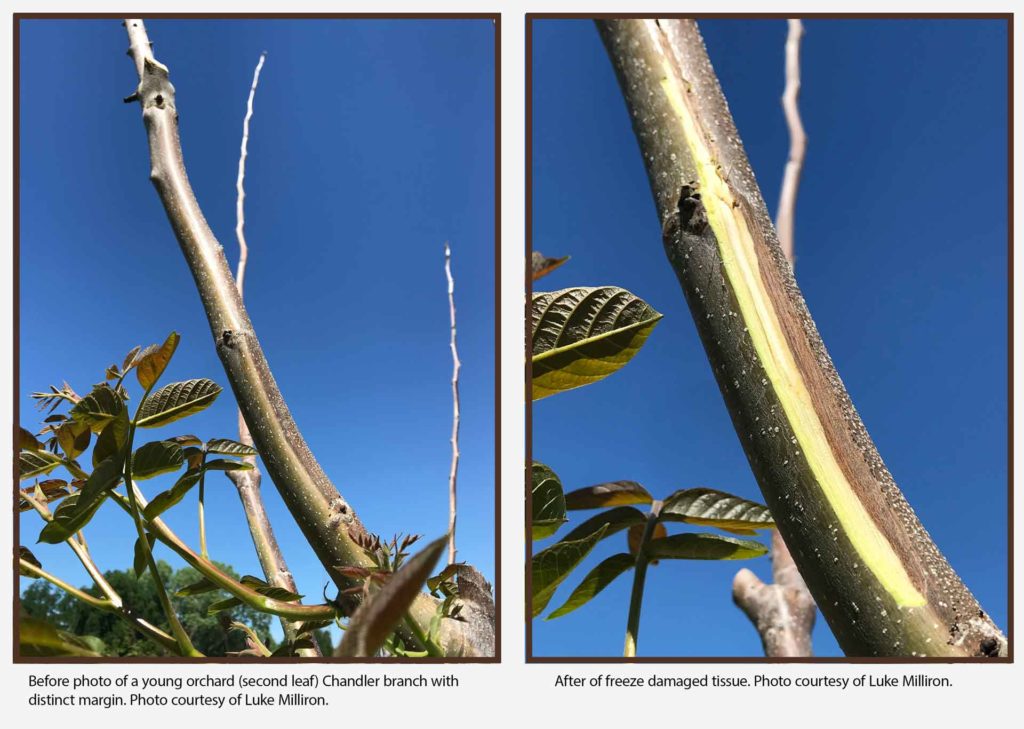Fully dormant mature walnut trees can tolerate temperatures into the low 20’s or below, so long as trees are in full dormancy, according to University of California Cooperative Extension (UCCE) farm advisor, emeritus, Wilbur Reil.
While it’s tempting to push young tree growth as long as possible in the fall, it’s also risky. Freezing temperatures can cause die back in young trees, sometimes almost to the roots. Freeze events can also severely damage trees in mid-winter if the soil is dry.
Fully dormant walnut trees can withstand temperatures well below freezing, but young trees are more susceptible to damage. It can be particularly damaging for young trees when temperatures drop to 28 degrees F or below before they’ve experienced a few nights near 32 degrees F to become acclimated.
Trees can be managed for cold hardiness by:
- Stop nitrogen fertilizer applications after September first to avoid new growth.
- Stop irrigation in mid-September until terminal vegetative bud set.
- Once the terminal vegetative bud has set by mid- to late-October, another irrigation can take place if there has been no rain. On both mature and young trees this will moisten the soil and prevent premature defoliation without pushing new growth.
- Use protective white latex paint on the trunks.
- Delay pruning until March after the threat of frost is past.
Mature Trees
Luke Milliron, UCCE orchard systems advisor for Butte, Glenn and Tehama counties said, the concern for fall freeze damage has historically been young walnuts, but mature trees can be susceptible, too, under the right circumstances.
Previously young trees, in particular, were associated with autumn early freeze events, but in November 2018 young and mature trees were severely impacted with freeze damage in early November, Milliron said.
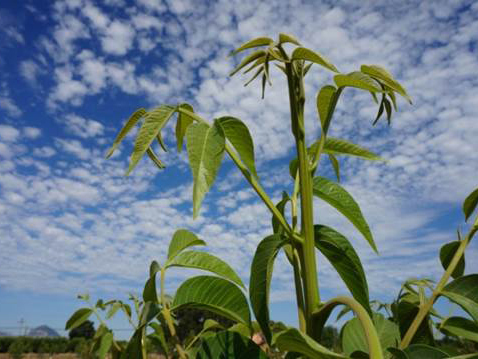
Whether mature or young trees, the advice remains the same, with increased caution for young trees, Milliron said.
“With young trees you don’t want all this new tender growth that gets freeze damage, so you start that process of not heading into autumn with a bunch of brand new growth,” Milliron said.
Water Management
Water management is a critical step to encouraging terminal bud set. Growers are advised to avoid irrigating in September until growth at the tips of the branches has stopped. Stop water until there is no new growth and red leaves, but not until the leaves yellow and defoliation occurs. Resume irrigation in October if there is no rainfall to ensure the soil is moist before a November freeze event.
“Withholding irrigation beginning in roughly mid-September until you see that a terminal vegetative bud has formed on the trunk,” Milliron said, is the best protection.
Milliron reminds growers that once the terminal vegetation bud is set water can be applied without resuming growth.
Higher Elevations
Rachel Elkins, UCCE pomology farm advisor and county director in Lake County, said, her growers typically get a certain amount late fall or winter injury every year because they’re at a higher elevation.
“We start our season later, and generally we can harvest into November,” Elkins said. “I’ve even seen us harvest into the very early part of December.”
When it comes to freeze injury, growers are used to it, Elkins said, but in 2018 freeze did come a little earlier.
Growers in Elkins area also had a great deal of rain this spring, so much rain in fact, sump pumps were running 24/7 because the water table was so high.
Elkins said, winter injuries are generally seen in weaker trees first, gravel areas, and southwest injury.
“For us I would say it’s a little bit more common (winter injury) than in other areas of the state,” Elkins said.
Elkins said, she thinks the very high water table that went into the spring also effected the trees in her area this year.
Elkins recommendations are similar to other farm advisors for young walnut trees. “I just always tell growers to make sure that they don’t irrigate them and fertilize them into the fall so that they keep growing because they’re very susceptible to severe winter injury,” she said, adding on mature trees it’s the same advice.
Latex Paint
Painting young trunks and shoots white can prevent freeze damage if applied prior to a freeze event. It can also minimize damage if applied as soon as possible after a freeze. Research by Bruce Lampinen UC walnut specialist showed painting after leaf fall with white interior latex paint diluted 50 percent with water minimizes damage to shoots and buds, especially on the southwest side of the tree. The paint helps moderate large temperature fluctuations between day and night after sunny winter days.
“Painting freeze damaged section of the tree can also improve recovery and protect against winter sunburn on affected tissue. Determine freeze damage by looking for darkened cambial tissue below the bark that resembles sunburn. This is generally found on the south and west side of the tree on horizontal branches.
Elkins also advises painting the trunk almost below the soil line. “That injury where the crown area meets soil line can be very susceptible, especially at planting,” she said.
Milliron advised, anytime there’s freeze damage to check the trunks and look for damage—specifically discoloration of the cambium layer.
“That’s going to be the main place where sunburn damage is going to occur,” Milliron said, adding for young and mature trees, but don’t paint the whole tree.
“We ran into some issues back in 2014-2015 where a lot of folks went out and they painted entire young trees,” Milliron said.
“We had a weird winter in terms of carbohydrates and budbreak where the buds just didn’t break where it was painted,” Milliron said, and that changed the whole energy balance of the tree. Instead, paint the southwest facing portion of the tree if damage is detected after a freeze event.
Painting damaged areas should be done as soon as possible after the freeze event.
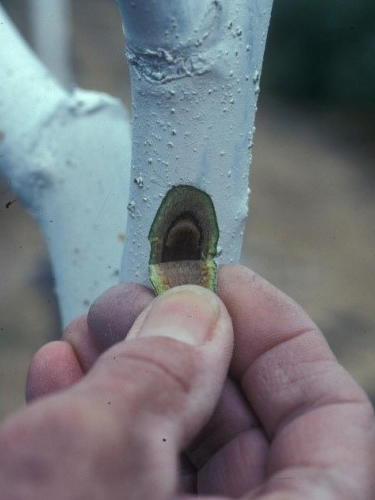
Dry Soil Before a Freeze Event
“By mid to late October if there hasn’t been rain it’s a good idea to irrigate, so that you’re not heading into November with things being dry like they were this past year,” Milliron said.
Not only was there minimal rainfall last fall until the very end of November, there was also very low relative humidity, with wind that created dry conditions, Milliron said.
“If conditions continue to be dry and you still have leaves on the tree that means you’re still losing some water, so irrigating can be a good idea,” Milliron said.
In the past, the focus of November freeze events has been young trees until 2018 when the freeze damaged both young and mature trees, Milliron said.
For young and mature trees, Milliron said that if the ground is dry and there’s a potential freeze event, irrigate.
Richard Snyder retired biometeorologist at UC Davis advises irrigating dry soil three to five days before the severe frost is predicted, Milliron said.
The goal is to rehydrate roughly the top foot of the profile to allow for more heat storage in the soil from the radiation during the day, Milliron said.
“You don’t want to be irrigating necessarily right before the freeze event because you don’t want saturated conditions or surface standing water,” Milliron said.







